Chapter 16
E-Commerce with a Soul
Understanding how a brand lives in cyberspace is the first thing. However, getting involved with e-commerce also requires that you figure out how to translate the virtual brand image into its analog dimension. Sure, you can propose great products online, but the “unboxing” of the goods happens in the real world. The designers interviewed here are comfortable creating digital content, but they are also aware that the quality of the thing they sell makes the difference. Ethical and environmental factors, as well as aesthetic values, are very much on their mind.
The good news is that you don't need to sell the farm to explore the possibilities of this new form of commerce. An increasing number of graphic designers create distinctively branded “indie” products they sell directly on their website. T-shirts and posters, but also fanzines, fonts, toys, and home accessories are routinely available in their virtual gift shops. The ventures may not bring in revenue, but they always enhance the identity and credibility of their creators, many of them championing the idea that graphic design can and should project itself into the third dimension.
In some rare cases, these online stores become the raison d'être of the websites. The mini-outlets slowly morph into a full-fledged commercial venues. Burö Destruct in Bern, Switzerland, sells designer toys and hip art supplies. Vier5 in Paris, France, publishes a men's fashion magazine and a very smart line of clothes. Aaron Draplin in Portland, Oregon, features Action Caps, Field Notes Pencils, and Dock Beanies on his carefully curated list of populist “merch.”
The next series of interviews features graphic designers who have jumped ship and embraced e-commerce as a full-time job.
Randy J. Hunt
Growing into a Job
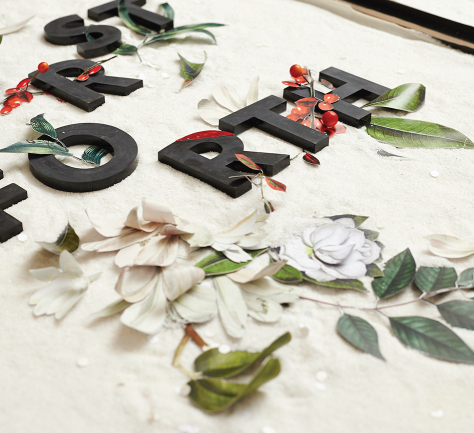
Holiday Seller Campaign 2013
Designers: Melissa Deckert, Nicole Licht, Jeremy Perez-Cruz
Photography: Aaron Cameron Muntz
What does Etsy mean?
The true meaning of the word “Etsy” is a secret known only to our founder, Rob Kalin. Any stories you may have heard about it are probably wrong. Or maybe they're right.
How did you get your position?
I grew and evolved into my current position at Etsy. I was given the opportunity to grow that team and eventually started what is now called our “brand design” team as well—communication design, art direction, illustration, and design for advertising and marketing needs. Along the way, I led and grew our product management, user research, and product marketing teams as well. It was helpful that as the company was growing, so was I. Also, the company's growth drove the need for design team growth as well. Thankfully, other leaders at Etsy respected both design and my point of view, and that allowed me to use resources and have their trust in developing design inside the company and the community.
In your role, what are your responsibilities?
As the voice of design for and within Etsy, I work to make sure design is part of our strategic discussions and informs and supports our decision making. This manifests itself most clearly in the digital products we build and in our brand communications, though it's often integral to many other parts of the company in less obvious ways. As a manager, my role is to make sure that designers have the information, resources, trust, and collaborators they need to get great work done. As leader inside the company, I work to set a great example and offer inspiration and guidance—often employing design to help make that happen—to help us fulfill the company's mission to reimagine commerce in ways that build a more fulfilling and lasting world.
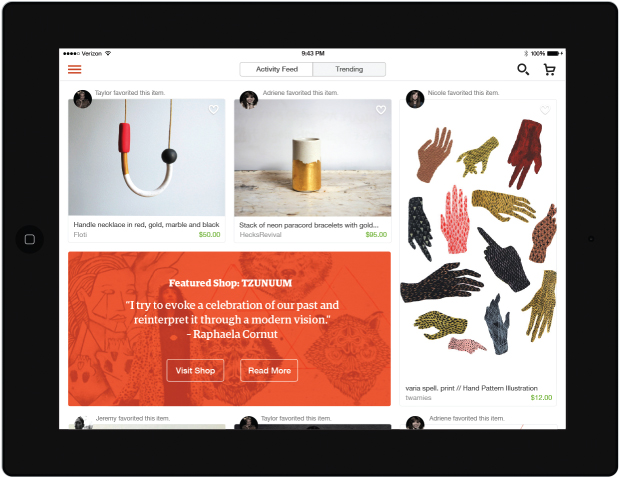
Etsy iPad App
Designer: Chesley Andrews
Does “leading” give you enough opportunity to design?
I work from the point of view that anything can be approached as a designer. These days I design high-level strategy, and I design teams. From time to time, I have the chance to engage in more elemental design work at Etsy, and also in projects I do in my leisure time. I'm equally satisfied and fulfilled with designing all along that spectrum.
When designing for an online company like this, what are the major responsibilities to the client?
One: preserving and amplifying the values and value of the brand. Two: facilitating scalability in both concept and execution of design work.
You have a large staff, and growing. What do you look for in designers?
I look for designers with strong fundamental design skills, typography most of all. I find the people who understand good typography also understand systems thinking, information organization and hierarchy, and it's a good way to judge their taste level. Beyond that, I'm looking for people who can communicate very well in written and spoken venues and who have an interest in problem solving more than beauty making. The elegant designs tend to come out of elegantly solving problems. Also, I'm always looking for what we call “world class and quietly awesome.” That means stellar work and low ego.
Are there different kinds of design skills that come to the fore in the digital age and space?
There are three skills that tend to be increasingly applicable:
- Time-based design: Interaction and user experience design is designing for experiences that take place over time. Understanding the arc of an experience over time is crucial. “Flows, not pages” we like to say.
- Systems thinking: The context of our choices are often complex systems. Being able to understand and design kits of parts and process that adapt to various inputs and circumstances is crucial.
- Software engineering: much of what we're designing is powered by and enabled by software. Being able to manipulate software is a powerful skill.
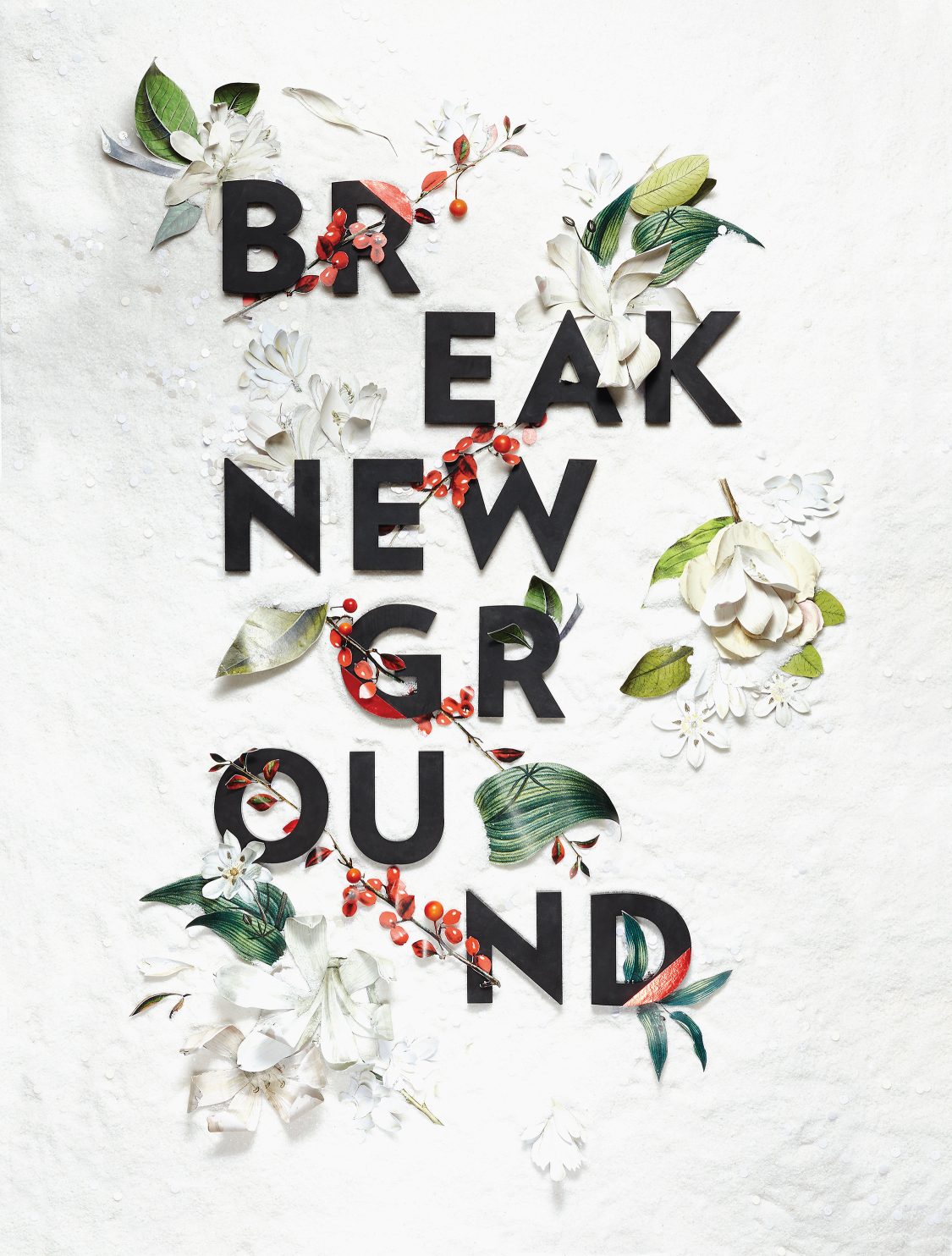
Holiday Seller Campaign 2013
Designers: Melissa Deckert, Nicole Licht, Jeremy Perez-Cruz
Photography: Aaron Cameron Muntz
These aren't the only skills that come in handy though, and so perhaps the most valuable of all is the interest and willingness to learn new skills.
For those looking to work in this online world, what should they show to get hired?
Great typography, a willingness to learn, entrepreneurial spirit, and designs for complex systems that they've put in front of real audiences and then iterated based on feedback and learnings.
Because we work in complex systems and address complex problems, designers who can write and can share their process are most prepared to succeed. Fundamental communication skills apply.
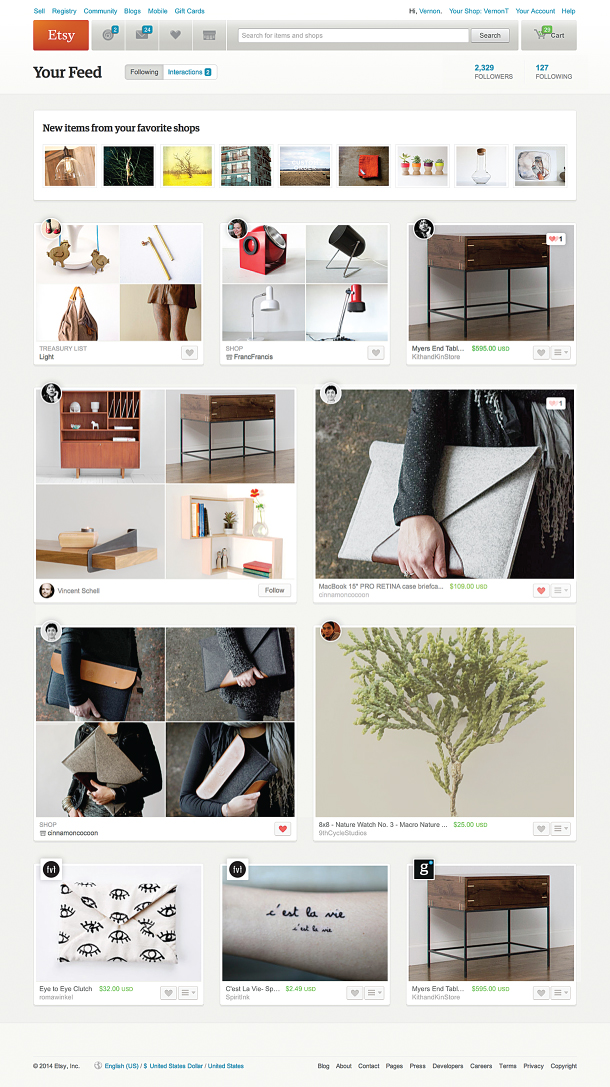
Activity Feed
Designer: Jung Park
Lucy Sisman
Online Editorial Ventures
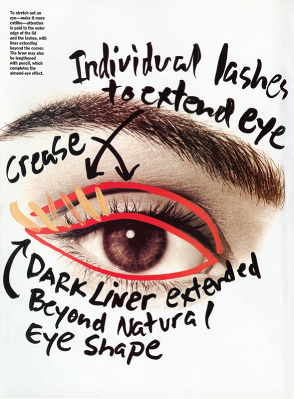
Allure Magazine
“Highbrow Eyebrows”
Client: Conde Nast
Art Director: Lucy Sisman
1991
What did you like most about being a magazine art director?
I loved working in magazines. I loved the pace, the drama, the discipline, the diversity of my job—from quiet moments working on layouts; crazy deadlines and all-nighters; bullish, rowdy competitive meetings; long collaborative hours in the studio or on location inventing images—and all with someone else picking up the bill.
I knew I loved design. My father had been a designer, and as a child I used to help him, so I knew something about the way a designer worked. What first appealed to me about design still intrigues and delights me: I like the tidiness of a well-thought-out design solution, the simplicity when everything falls into place. I've always believed that, if a designer does thorough and exhaustive research at the beginning of any job, then it will work out well. Research can mean anything from asking the right questions to using the right pencil.
Yet, somehow, you never “signed up.” Even as the founding art director of Allure magazine, you remained a freelancer. Why?
There is something about working for somebody else that I just don't like. I wanted to feel that I could just walk out if it got too unreasonable or unbearably punishing. Of course, I never did, but all the time I worked at Allure I kept my own office. So when I finally left Condé Nast, I went back and built it back up.
I was determined not to be pigeonholed into one area of design: I liked working on editorial, advertising, books, corporate identities, branding, logos, packaging, TV, and video—and I wanted young, energetic people around me who enjoyed working on a wide range of things, too.
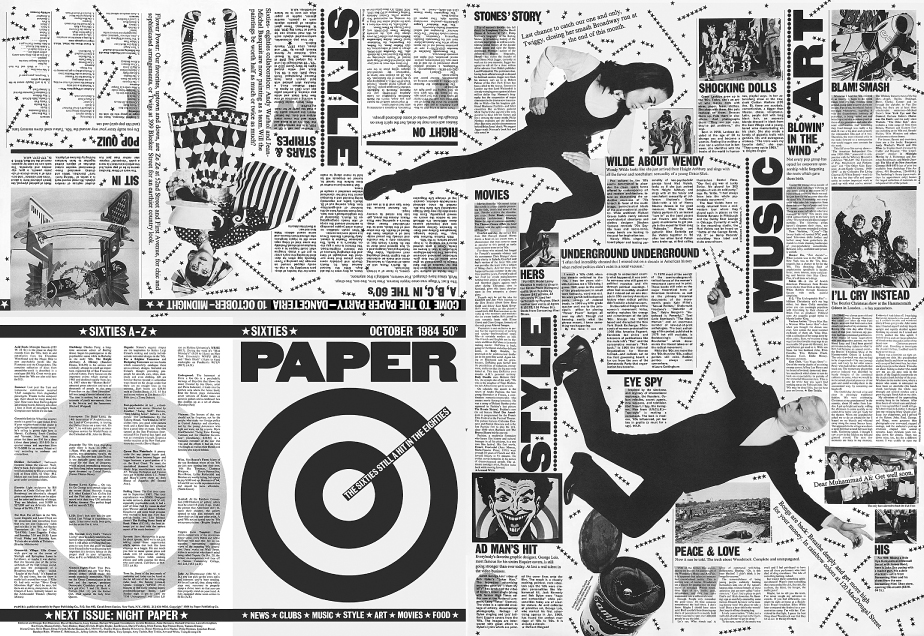
Paper: Sixties Issue
Client: Paper magazine
Art Director: Lucy Sisman
1984
During that time, you became quite successful as a branding consultant. Why did you eventually turn your back on this profession?
It wasn't so much that I turned my back on branding, it's just that I felt I'd got far away from design. I had great clients—The Limited, Express, Victoria's Secret, Abercrombie, Sony, Shiseido, P.S.1, Revlon, Bruno Magli, Lilly Pulitzer, Sears, Diesel, Johnson & Johnson, Clairol, Ralph Lauren, LVMH—but one of the downsides of success is often that it takes you away from what you really love to do. At a certain point, I got tired of marketing directors, negotiating contracts, dealing with temperamental employees, struggling when times were hard, and I thought how nice it would be to go and read all the books that I'd always wanted to read.
So, again, I gave it all up and went to Oxford to study English for a few years. I didn't really know what I would do afterwards, but I thought that would just take care of itself.
Did it?
Yes, but it wasn't straightforward. After Oxford, I came back to New York to work on a “green” magazine with an old friend from Condé Nast. The idea morphed a bit—magazine turned into website and then into a store—but my partner wasn't really interested in commerce, so he bailed and I was left with this new interest in making things. Through a rather circuitous route, I found a woman in India who knew women who needed work, so we landed on this idea to make scarves from vintage saris, using a unique traditional stitching technique. Pretty soon we had over 30 women working for us. We called our e-commerce venture “MiddleBlue.” We work on Skype.
Did your understanding of graphic design principles play a role in your entrepreneurial venture?
I'm not sure how anybody can start any kind of company if they aren't a designer, as there's so much graphic design involved from the logo onwards—labels, tags, press kits, promotional material, posters, website—it's never ending. But beyond that, designers are trained to solve problems, and being an entrepreneur is all about problem solving: starting at the beginning and then doing 500 things all at once, each one equally important and urgent.
As an entrepreneur, I also had to grow as a designer. One of the key things has been learning that new technology and keeping up with it: retouching my own pictures or mocking up some dummy packaging myself, for instance. Independence is vital. In the old days, I had people to do this kind of thing for me, but the world doesn't work this way anymore.
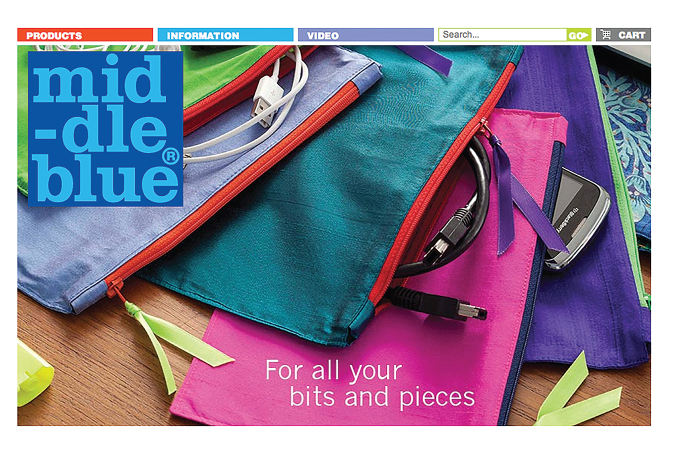
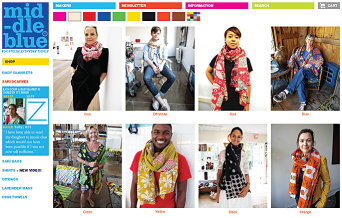
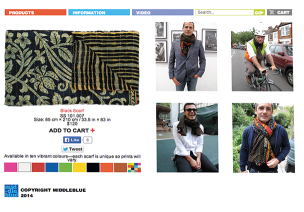
MiddleBlue Website
Art Director: Lucy Sisman
2014
How would you define the very special visual characteristics of your product line?
What I sell is handmade, so I thought it was important to make the site feel as friendly as possible. The other thing is, I didn't want to spend money on photography, particularly at the beginning when everything was an outgoing expense. It then seemed obvious to shoot my friends wearing what I sold, so, in effect, I'm constantly updating the photography. It's very straightforward—daylight, no hair or makeup—but that's the kind of photography I like anyway.
In your experience, what are the most critical design features of a website that sells goods online?
A good website—for anything—has to be simple and work quickly. It's hard working on your own site, where you're the client as well as the designer. It's important to have conversations with yourself, so you can criticize the work without the inner designer getting offended and ignoring practical needs altogether.
Nancy Kruger Cohen
Addicted to Start-ups
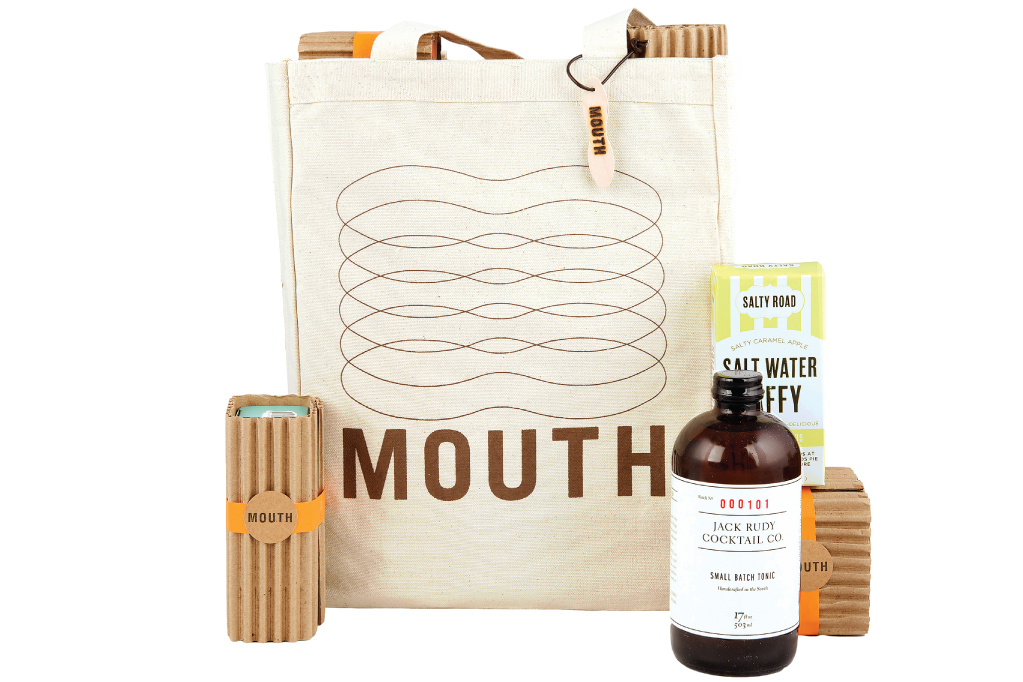
Mouth Packaging
Art Director: Nancy Kruger Cohen
How did you go from being an art director (Metropolis magazine, and more) to getting involved with an e-commerce venture, and what lessons have you learned along the way?
I was always interested in both writing and design, so I was drawn to magazines from the start. I was lucky to land at Metropolis, and then at ESPN magazine. Although not a sports fan, I realized that I could develop strong opinions about any subject, as long as I cared about the mission, process, and people.
After a few more magazine stints, I shifted into advertising at the agency Carlson & Partners. My client was Polo Ralph Lauren. My job was to create what was then called a “magalog”— a cross between a magazine and a catalog—for which I oversaw everything from photography to writing to design. From there, I became a consultant, creating print and TV ads, books, and identity branding for all sorts of clients. All of these work environments, by the way, were essentially start-ups. I'm addicted to a certain type of intensity and tend to gravitate to challenging projects like redesigns and new brands—basically, creating something from nothing.
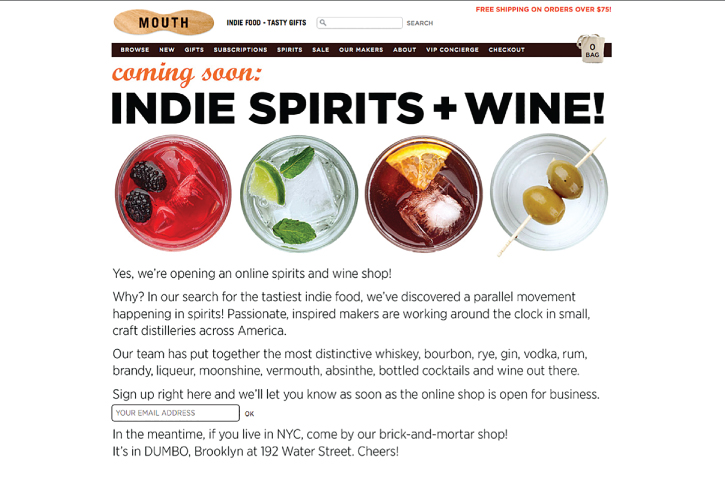
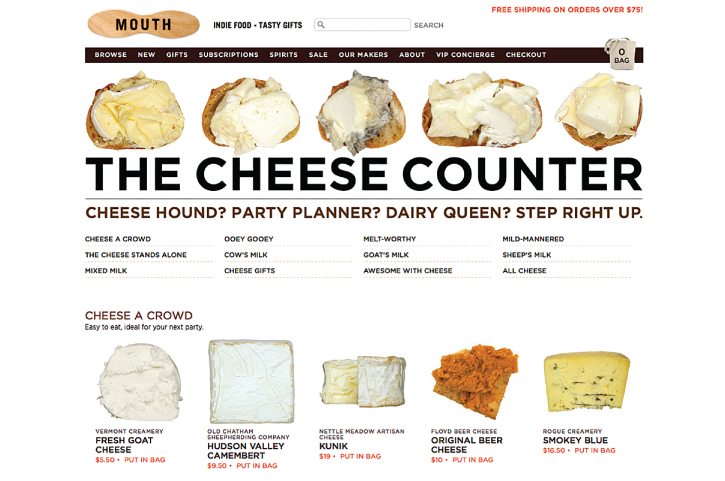
Mouth Website
Art Director: Nancy Kruger Cohen
Is that why working at a start-up appealed to you?
Yes. I was ready for it. From Ralph Lauren, I had learned about the importance of “the brand”—of a clear and consistent message. It was invaluable. But it got a little frustrating and soon I was ready to move into the business side of a creative project. As much as I had loved diving deep into photography (I had worked with Bruce Weber and witnessed a true artist up close), I knew I needed to get back to words and concepts.
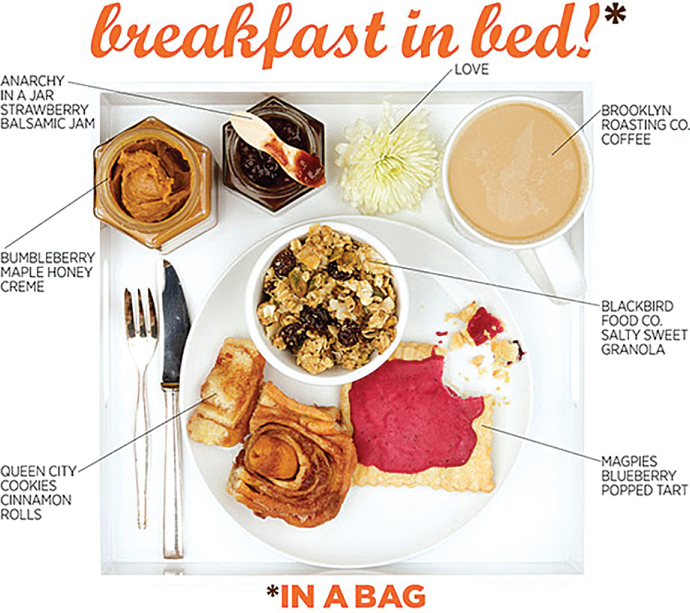
Mouth Breakfast in Bed
Art Director: Nancy Kruger Cohen
At the same time, your understanding of graphic design principles must have helped you establish the visual presence of Mouth.
Absolutely. I was brought in to help create a brand, which began with establishing a clear point of view about who we were: friendly, witty, and . . . hungry! Image and words needed to work together to form an accessible, conversational voice. So our site design is clean and makes use of the grid and white space. The colors are vibrant, and the photography is visceral. The typography is simple and unfussy (I am a sucker for a classic sans serif paired with a hit of retro script). And the logo is a vernacular object, a hand-branded wooden tasting spoon.
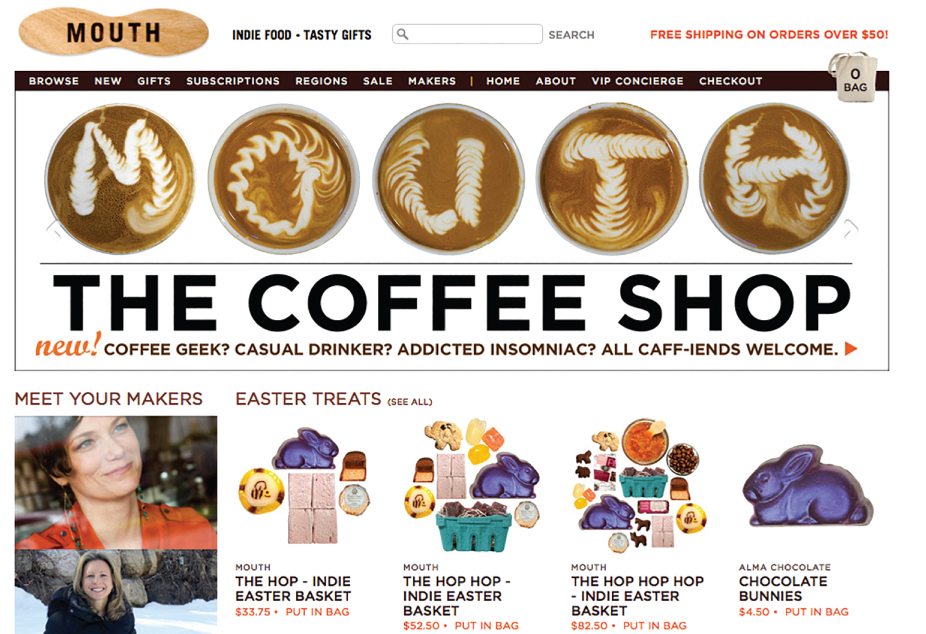
Mouth Website
Art Director: Nancy Kruger Cohen
What are the most critical design features of a website that sells goods online?
The brand experience needs to be consistent from start to finish, from website home page to the checkout to the final bag of goodies that arrives by mail. The user experience, at the same time, must be easy, without too many layers of clicking.
You also developed original packaging to ship the products you sell. Why is this so important, and did you need special skills?
The “unboxing” is a key brand moment. So this was just another design challenge of a different sort—coming up with a creative yet functional way to wrap and ship the products so that our voice would carry through.
Photography plays an important role in establishing the Mouth brand. How would you define the very special visual characteristics of your site?
Above all, the site needs to be mouthwatering. Most online food stores just show packaging, but we make it a point to show the FOOD itself. Our photography tries to replicate the experience of being at a market, opening the jar, and having a taste. Our CEO, Craig Kanarick, is our photographer, and I pinch-hit as food stylist!
So you write in your spare time, you are the mother of two girls, and you are involved in a number of community projects. Is there a connection between all your interests and talents?
The connection is me. These are all the things I love and care about. And I put 100 percent into anything I'm doing. Whether I'm writing an e-blast, designing a home page carousel, art directing a pro bono invite for the local school, or assembling a birthday party goodie bag—it's just me being me, interested and invested in the ideas and people I care about. I no longer compartmentalize my interests and skills. Graphic designer, writer, mother—I'm not sure I see a need for these labels anymore. I'm not in a box.
What is the most interesting part of your day?
I love the diversity. Working with our tech people to improve site navigation. Creating marketing postcards or new tote bags. Writing and designing e-blasts. Curating new gift collections. Brainstorming promotions. My partners are brilliant and make me laugh, daily. And, of course, I love the food. Snacking is a job requirement!